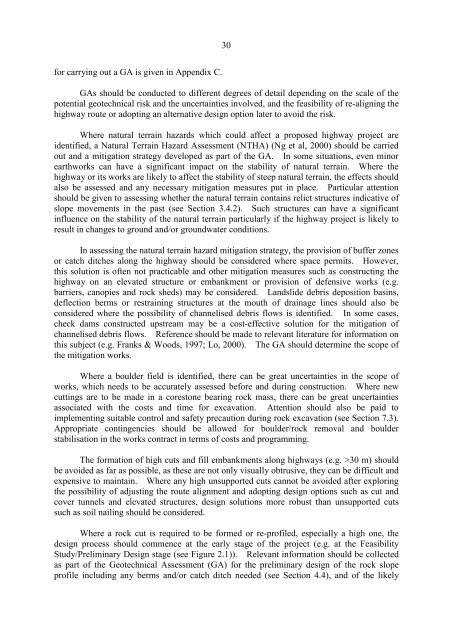Highway Slope Manual
Highway Slope Manual
Highway Slope Manual
Create successful ePaper yourself
Turn your PDF publications into a flip-book with our unique Google optimized e-Paper software.
30<br />
for carrying out a GA is given in Appendix C.<br />
GAs should be conducted to different degrees of detail depending on the scale of the<br />
potential geotechnical risk and the uncertainties involved, and the feasibility of re-aligning the<br />
highway route or adopting an alternative design option later to avoid the risk.<br />
Where natural terrain hazards which could affect a proposed highway project are<br />
identified, a Natural Terrain Hazard Assessment (NTHA) (Ng et al, 2000) should be carried<br />
out and a mitigation strategy developed as part of the GA. In some situations, even minor<br />
earthworks can have a significant impact on the stability of natural terrain. Where the<br />
highway or its works are likely to affect the stability of steep natural terrain, the effects should<br />
also be assessed and any necessary mitigation measures put in place. Particular attention<br />
should be given to assessing whether the natural terrain contains relict structures indicative of<br />
slope movements in the past (see Section 3.4.2). Such structures can have a significant<br />
influence on the stability of the natural terrain particularly if the highway project is likely to<br />
result in changes to ground and/or groundwater conditions.<br />
In assessing the natural terrain hazard mitigation strategy, the provision of buffer zones<br />
or catch ditches along the highway should be considered where space permits. However,<br />
this solution is often not practicable and other mitigation measures such as constructing the<br />
highway on an elevated structure or embankment or provision of defensive works (e.g.<br />
barriers, canopies and rock sheds) may be considered. andslide debris deposition basins,<br />
deflection berms or restraining structures at the mouth of drainage lines should also be<br />
considered where the possibility of channelised debris flows is identified. In some cases,<br />
check dams constructed upstream may be a cost-effective solution for the mitigation of<br />
channelised debris flows. Reference should be made to relevant literature for information on<br />
this subject (e.g. Franks Woods, 1997; o, 2000). The GA should determine the scope of<br />
the mitigation works.<br />
Where a boulder field is identified, there can be great uncertainties in the scope of<br />
works, which needs to be accurately assessed before and during construction. Where new<br />
cuttings are to be made in a corestone bearing rock mass, there can be great uncertainties<br />
associated with the costs and time for excavation. Attention should also be paid to<br />
implementing suitable control and safety precaution during rock excavation (see Section 7.3).<br />
Appropriate contingencies should be allowed for boulder/rock removal and boulder<br />
stabilisation in the works contract in terms of costs and programming.<br />
The formation of high cuts and fill embankments along highways (e.g. 30 m) should<br />
be avoided as far as possible, as these are not only visually obtrusive, they can be difficult and<br />
expensive to maintain. Where any high unsupported cuts cannot be avoided after exploring<br />
the possibility of adjusting the route alignment and adopting design options such as cut and<br />
cover tunnels and elevated structures, design solutions more robust than unsupported cuts<br />
such as soil nailing should be considered.<br />
Where a rock cut is required to be formed or re-profiled, especially a high one, the<br />
design process should commence at the early stage of the project (e.g. at the Feasibility<br />
Study/Preliminary Design stage (see Figure 2.1)). Relevant information should be collected<br />
as part of the Geotechnical Assessment (GA) for the preliminary design of the rock slope<br />
profile including any berms and/or catch ditch needed (see Section 4.4), and of the likely

















